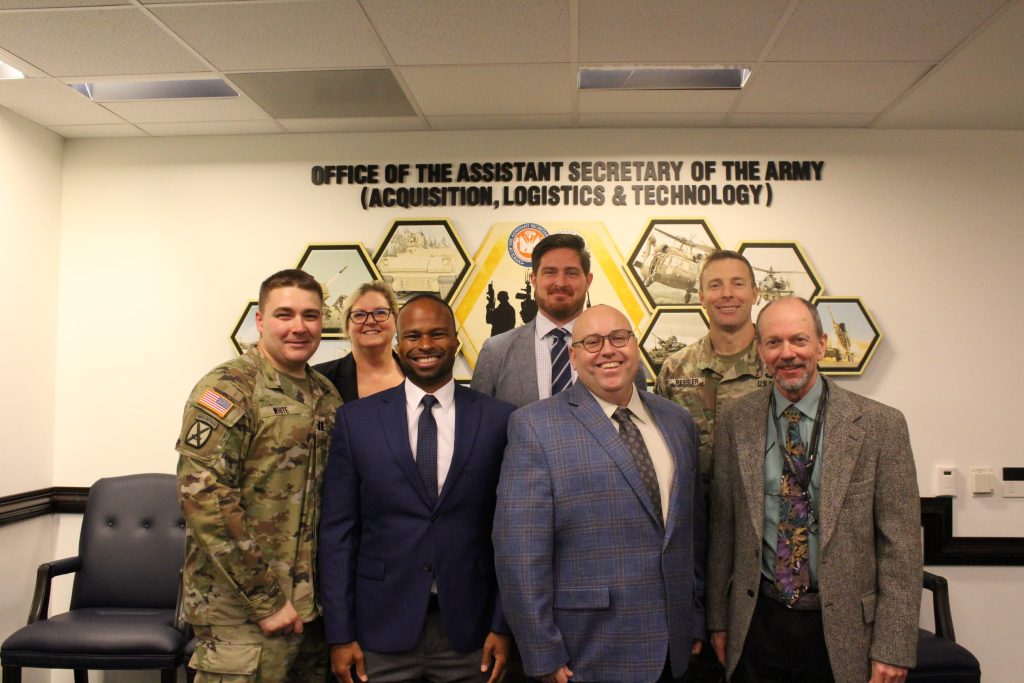
IN THE MIDDLE: A DASC is a middleman—located in the Pentagon, they can attend meetings and respond to tasks on behalf of a program or product management office, and then relay any messages or tasks back to that office. (Image by Getty Images)
An Army civilian delivers capabilities to Soldiers while LEAD-ing with experience.
by Cody Swinford
I arrived at the Pentagon at the end of February 2022 just as many of the COVID restrictions were being lifted, but the foot traffic was still sparse as most people were still at maximum telework. I was there as a part of the 24-month Leadership Excellence and Acquisition Development (LEAD) program to start my temporary assignment as a Department of the Army Systems Coordinator (DASC). As I was getting acclimated to the building and browsing the Fort America store on the second floor, I noticed a t-shirt that caused me to both think and chuckle. It said, “I Made It Inside the Pentagon.”
Security is a priority and is maintained to the greatest extent possible whether you are coming as a visitor on business or, like me, as part of your job. The bustling activity at the main entrance is hectic but runs like a well-oiled machine. Once inside, going up the escalators, you land on what looks like a shopping mall area with everything from banking to vision care, a flower shop, a CVS pharmacy and of course the smell of coffee and food from the many vendors nearby.
To those outside of DOD, the five-sided building is a symbol of our nation’s military strength and is where each of the military services’ leadership is located, and where decisions about national defense are made. When I told family and friends from my small, Southern middle Tennessee town that I would be working at the Pentagon, they were in awe and wonder about what I would be doing. The adage that “If I told you, I’d have to kill you,” came to mind. My family made me feel more important than I know I really am. In my now 25-year career, my job has always been to deliver capabilities to the men and women wearing the uniform. This is exactly what I would continue to do as a DASC.

A TEAM EFFORT: Swinford, front row, second from right, enjoyed his time as a DASC with Soldier and Maneuver Directorate colleagues, from rear left, Judy Gachupin, Jonathan Brown, Maj. Ryan Ressler, Capt. Tony White, Carlton White and David Nelson.
WHAT IS A DASC?
A DASC works in the Office of the Assistant Secretary of the Army for Acquisition, Logistics and Technology (OASA(ALT)) for the Army Acquisition Executive (AAE). We are the liaisons among the (OASA(ALT)) staff, and the numerous program executive offices (PEOs) located around the country, supporting the program management offices that design, develop, procure, deliver and sustain everything a Soldier wears, drives, flies, fires and uses to make them successful. DASCs are primarily Army civilians, majors and lieutenant colonels.
I got to the Pentagon and the OASA(ALT) as a result of the LEAD program, which is open to mid-career professionals like me. I applied and was accepted, and the program began in May 2021.
LEAD uses my current skills in business, but also prepares me for positions of greater responsibility within the Army acquisition community and, in particular, program management. The goal of the two-year program—while not a guarantee—is to be promoted and potentially selected to serve as a program manager at either the lieutenant colonel or colonel level. The six-month assignment at the Pentagon is just one of three phases bookended between two longer nine-month positions at my primary duty location, which is Redstone Arsenal in Huntsville, Alabama.
As a DASC, I worked with the Mobile Protective Firepower, Stryker brigade combat team and Vehicle Protection Suite portfolios within the Soldier and Maneuver Directorate, which supports PEO Ground Combat Systems in Warren, Michigan. I served as the eyes and ears of these programs in the building and could be either proactive or reactive, depending on the circumstances. Most DASCs manage multiple programs, depending on the size and scope and where the program is in the acquisition life cycle. By being located in the Pentagon, DASCs can attend meetings on behalf of the programs and respond quickly to tasks related to our programs, and then relay any messages to our offices.

A NEW PATH: Though Swinford’s prior experience was in PEO Aviation and PEO Missiles and Space, he had to quickly learn about ground combat systems in order to respond to represent the Army’s interests during key briefings and engagements. (Image by Getty Images)
ARMY PROGRAM BUDGET BRIEFS
A system coordinator’s job is to maintain the Army’s position for our programs and work all related aspects of cost, schedule and performance between our program and product managers and Army staff offices that support plans, programs and resources at the Army headquarters level. While we support or represent the different PEOs, program and product managers, we work for the OASA(ALT)—it is our job to represent the intentions of the headquarters. Shortly after I started, I was told I would need to start preparing for key briefings and engagements. The annual budget cycle begins after the president’s state of the union address is delivered and his budget is released to Congress. I would quickly need to become an “expert” for the programs I would be supporting.
Though my background was working for PEO Aviation and PEO Missiles and Space, now, I would need to learn about ground combat systems. So, over the next month, I drafted, reviewed and updated the current and near-term status of the Stryker brigade combat team and the Vehicle Protection Suite while working intimately with the program manager and support staff to learn as much about the program as I possibly could so I could relay a clear, concise and consistent message to Congress.
We develop what are called Army program budget briefs—presentations to Senate and House appropriations committees—to outline the Army’s position regarding the upcoming fiscal year requirements. It is our opportunity to explain how and what each program or product management office did with the money Congress appropriated to our programs last year. That might include how many systems we procured or key test events that took place.
We also defend and justify what program management offices can and cannot do with the funding originally planned for in the program objective memorandum, based on potential increases or decreases to the overall defense budget. After the briefings, we respond to requests for information related to our programs throughout the end of the budget cycle, when both the Senate and House pass the defense appropriation for the next fiscal year.

SWINFORD IS IN THE BUILDING : Swinford’s participation in the LEAD program included a six-month assignment at the Pentagon. (Photo by Staff Sgt. Brittany A. Chase, U.S. Air Force)
OTHER DUTIES
Aside from those briefs, the DASC builds relationships with the program managers and helps them resolve complex problems with their programs by navigating assistance from Army senior leaders and staff functional offices. For instance, the secretary of the Army was asked during Congressional testimony about active protection systems. Since it pertained to one of my programs, the Vehicle Protection Suite, it was my job to work with the program manager to draft an information paper related to this topic, so that the secretary was aware of the current state and could provide a formal response back to Congress on this topic if necessary.
We also play an integral part when a program has a milestone decision review, by assisting the program office with coordinating meetings with key players and decision-makers. The DASCs also host the milestone decision review meeting, take notes and respond to any after-action reports or follow-up questions. Midway through my DASC assignment, I was asked to do just that and assist the Mobile Protected Firepower program to attain final approval for its Milestone C so it could award a low-rate initial production contract. It was an exciting time for both the program and the Army as it was the first acquisition program to successfully transition from a middle-tier acquisition pathway to a major-capability acquisition pathway. And while most of the leg work had been accomplished before my involvement, assisting with those final briefings helped me gain a better appreciation and understanding of the life cycle process we are involved in daily.

CONCLUSION
My six-month tour at the Pentagon and the experience I received in OASA(ALT) as a DASC were invaluable and helped to broaden and deepen my skills as an acquisition professional. I learned how to maneuver the ins and outs of the acquisition process, from down at the program and product manager and PEO levels up through the upper chain of command at Army headquarters.
The LEAD program has allowed me to explore the opportunities in Army acquisition that are outside of my career path. For someone looking for a change, it is a great program to consider. My DASC assignment has helped me build a background of knowledge and information, as well as a network of contacts to make me successful in any Army acquisition program or product team I join in the future. It will certainly make me a more effective leader because of my understanding of the larger Army mission as it relates to acquisition and getting capabilities into Soldiers’ hands.
For more information about the LEAD program, go to https://asc.army.mil/web/career-development/programs/lead/.
CODY SWINFORD has worked for the Army for 25 years, including four years on active duty as an enlisted Soldier, and supported multiple PEOs and program and product management offices, including PEO Aviation, PEO Ground Combat Systems and PEO Missiles and Space. He is currently participating in the LEAD program. In September, he transitioned to Phase III, and is assigned to the Rapid Capabilities and Critical Technologies Office at Redstone Arsenal in Huntsville, Alabama. He has an M.S. in management, acquisition and contracts from the Florida Institute of Technology and a B.S. in secondary education from Athens State University. He holds Advanced credentials in business, cost estimating and financial management, and a Practitioner credential in program management.







